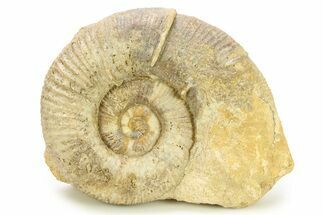This Specimen has been sold.
Three Ammonite (Hammatoceras) Fossils - Belmont, France
This is an association of three fossil ammonites of the genus Hammatoceras that was collected near Belmont, France. They are Toarcian (Jurassic period) in age, or approximately 180 million years old. The larger ammonite is 4.4" wide and the smaller ammonites measure 3.3" and 1.8" wide. The ammonites have been partially exposed from the rock they were found in, with one edge cut flat for presentation purposes. There is a partial, unidentified belemnite near the base of this specimen.
About Ammonites
Ammonites were ancient marine cephalopods, similar to today's squids and octopuses, but with a defining feature: their distinctive, tightly coiled spiral shells. These shells, resembling those of modern nautiluses, served as both a protective home and a buoyancy aid, allowing ammonites to navigate the prehistoric seas with ease. First emerging around 240 million years ago in the Triassic Period, ammonites thrived for over 175 million years, adapting through numerous forms and sizes. As predatory creatures, they likely fed on smaller marine organisms, using their tentacles to capture prey. However, their long reign came to an end 65 million years ago at the close of the Cretaceous, coinciding with the mass extinction event that also eliminated the dinosaurs.
Ammonites were ancient marine cephalopods, similar to today's squids and octopuses, but with a defining feature: their distinctive, tightly coiled spiral shells. These shells, resembling those of modern nautiluses, served as both a protective home and a buoyancy aid, allowing ammonites to navigate the prehistoric seas with ease. First emerging around 240 million years ago in the Triassic Period, ammonites thrived for over 175 million years, adapting through numerous forms and sizes. As predatory creatures, they likely fed on smaller marine organisms, using their tentacles to capture prey. However, their long reign came to an end 65 million years ago at the close of the Cretaceous, coinciding with the mass extinction event that also eliminated the dinosaurs.
SPECIES
Hammatoceras sp.
LOCATION
Belmont, France
SIZE
Largest Ammonite: 4.4" wide, Entire specimen: 7 x 6.2"
CATEGORY
SUB CATEGORY
ITEM
#191716
We guarantee the authenticity of all of our specimens.
 Reviews
Reviews














